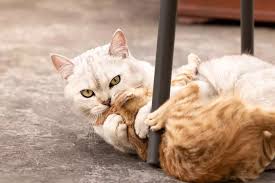You dreamed of harmony between your cats, but instead, you’re seeing tension and fights. If you’re asking yourself “why does my younger cat bullying my older cat?”, this guide explains the reasons behind the behavior and practical steps to restore peace in your multi-cat home.
If you’ve asked yourself, “Why does my younger cat bully my older cat?”, you’re not alone. Many cat owners struggle with this exact problem, especially when a once-harmonious relationship suddenly changes or when a playful kitten grows into a bold, pushy adult.
This article will break down everything you need to know about feline bullying, including:
-
Why younger cats often target older cats
-
How to distinguish play from bullying
-
The role of age, energy levels, and territory
-
Step-by-step solutions to restore peace
-
Mistakes to avoid when managing cat conflicts
-
Real-life scenarios and expert advice
-
FAQs addressing the trickiest situations
By the end, you’ll not only understand what’s happening in your home, but you’ll also have practical strategies to help both cats coexist — and maybe even become friends again.

What Does “Bullying” in Cats Actually Mean?
Before jumping into causes, let’s define what we mean by bullying.
Bullying in cats refers to repeated, one-sided aggressive or dominant behavior from one cat toward another, causing stress or limiting the bullied cat’s access to resources (food, water, litter box, resting spots).
Typical bullying behaviors include:
-
Stalking and ambushing the older cat
-
Blocking access to food bowls or litter boxes
-
Swatting, biting, or pinning down without mutual play
-
Chasing until the older cat hides
-
Staring intensely or looming to intimidate
It’s important to distinguish this from normal play, which often looks rough but has clear signals: both cats take turns chasing, there are short pauses, and neither cat seems consistently stressed.
Why Younger Cats Bully Older Cats: The Key Reasons
1. Energy Mismatch
Young cats, especially under three years old, are bundles of energy. They need constant stimulation, play, and outlets for hunting instincts. Older cats, on the other hand, prefer rest and slower-paced activity.
When a younger cat tries to initiate play, the older cat often resists. Frustration can turn playful attempts into pestering or bullying behavior.
2. Territorial Behavior and Hierarchy
Cats are territorial animals. A younger cat may test boundaries, asserting dominance over food, litter, or sleeping areas. This behavior can escalate into bullying if left unchecked.
In multi-cat homes, a hierarchy often forms. Sometimes the younger cat simply challenges the older cat’s authority, especially if the older cat is sick or less active.
3. Redirected Aggression
Cats sometimes release frustration onto each other. For example, if your younger cat sees a bird outside but can’t reach it, they might redirect that pent-up energy onto the older cat.
4. Lack of Enrichment
If the younger cat doesn’t have enough toys, climbing spaces, or interaction with you, they may turn to the older cat for entertainment — even if it annoys them.
5. Health Problems in the Older Cat
Older cats often move slower, smell different, or give off subtle signals when unwell. Younger cats may perceive this as weakness and take advantage of it, either instinctively or due to stress about changes in their feline companion.
6. Socialization Gaps
If the younger cat wasn’t well-socialized as a kitten — especially with other cats — they may not understand feline etiquette. Instead of playful chasing, they may cross the line into harassment.

The Impact of Bullying on Older Cats
Bullying isn’t just stressful to watch — it can harm your older cat’s physical and emotional health.
Signs your older cat is being negatively affected include:
-
Hiding more than usual
-
Avoiding food, water, or the litter box because the younger cat blocks access
-
Weight loss or dehydration
-
Excessive grooming (stress response)
-
Acting withdrawn, less affectionate, or irritable
Left unchecked, bullying can lead to serious health problems due to stress and inadequate access to resources.
How to Tell If It’s Play or Bullying
It’s easy to misinterpret rough play as aggression — or to overlook genuine bullying. Here are key differences:
Play:
-
Both cats take turns chasing or being on top
-
Ears and tails are relaxed between play bouts
-
There are breaks in activity
-
No hissing, yowling, or fearful hiding afterward
Bullying:
-
One cat always initiates, the other always retreats
-
The older cat hides, growls, or hisses frequently
-
The younger cat blocks paths or resources
-
The older cat looks stressed, not engaged
Step-by-Step Solutions to Stop a Younger Cat Bullying an Older Cat
1. Provide Multiple Resources
-
Multiple food bowls, water stations, and litter boxes (at least one per cat, plus one extra).
-
Place them in separate areas so the younger cat can’t guard them all.
2. Create Safe Zones for the Older Cat
-
Vertical spaces like cat trees or shelves where the younger cat can’t easily reach.
-
Gated or closed-off rooms that the older cat can retreat to with essentials inside.
3. Increase Playtime with the Younger Cat
-
Dedicate 15–20 minutes twice daily to interactive play (feather wands, laser toys).
-
This helps release pent-up energy so your younger cat doesn’t redirect it onto the older cat.
4. Use Positive Reinforcement
-
Reward calm, non-aggressive behavior with treats or praise.
-
If you catch the younger cat harassing, redirect with toys — not punishment.
5. Pheromone Diffusers and Calming Aids
-
Products like Feliway can help reduce tension by mimicking calming pheromones.
6. Gradual Reintroduction
If bullying has escalated badly, consider separating the cats and reintroducing them slowly, as if they’re meeting for the first time. This helps reset the relationship.
7. Veterinary Checkups
Ensure both cats are healthy. Pain or illness in either cat can fuel aggression.
Mistakes Owners Make When Dealing With Cat Bullying
-
Yelling or punishing: Cats don’t associate punishment with their behavior. It only adds stress.
-
Letting them “work it out”: Unlike dogs, cats rarely resolve bullying on their own. Intervention is often needed.
-
Only focusing on the victim: The younger cat also needs attention, play, and guidance to channel energy appropriately.
-
Not addressing resources: Many conflicts stem from limited litter boxes, feeding spots, or resting places.
Real-Life Example
One cat owner noticed her 2-year-old Bengal constantly chasing her 12-year-old Persian. The Persian began hiding in the laundry room and lost weight. By adding an extra litter box upstairs, creating high perches, and dedicating playtime for the Bengal, the dynamic shifted. Within a few weeks, the older cat regained confidence, and the bullying subsided.
Tips for Long-Term Harmony
-
Rotate toys to keep the younger cat engaged.
-
Use puzzle feeders to mentally stimulate both cats.
-
Ensure both cats receive individual affection from you.
-
Keep vet visits regular to monitor health changes that might influence behavior.
-
Consider consulting a feline behaviorist if the problem persists.
Expert Insights
Animal behaviorists stress that what looks like bullying is often a mismatch of energy and needs. Younger cats require structured play and outlets for energy, while older cats need peace and predictability. Success comes when owners create a balance that respects both.
FAQs: Younger Cat Bullying Older Cat
Q: Will my younger cat grow out of bullying behavior?
A: Some cats mellow with age, but without intervention, the behavior can become a long-term habit.
Q: Should I separate my cats permanently?
A: Not usually. Temporary separation with a structured reintroduction is better than permanent isolation.
Q: Can spaying or neutering help reduce bullying?
A: Yes, it can reduce territorial and aggressive tendencies, especially in younger males.
Q: My older cat has started avoiding the litter box — is this due to bullying?
A: Very likely. If the younger cat blocks access, your older cat may avoid it. Adding extra litter boxes in different locations usually helps.
Q: Are certain breeds more prone to bullying?
A: High-energy breeds like Bengals, Siamese, and Abyssinians are more likely to pester calm breeds, but any cat can develop bullying behavior.
Q: What if the bullying turns violent?
A: Separate immediately and contact a vet or feline behaviorist. Persistent aggression can sometimes require medication or structured training.
Final Thoughts: Restoring Peace Between Cats
When your younger cat bullies your older cat, it’s not just annoying — it can damage the well-being of both cats and your household harmony. But with patience, environmental adjustments, and consistent management, most cats can learn to coexist peacefully.
Remember: your younger cat isn’t “bad,” and your older cat isn’t “weak.” They simply have different needs. By respecting both and creating balance, you’ll help them build tolerance — and maybe even companionship — in time.
So the next time you wonder, “Why does my younger cat bully my older cat?”, know that the answer lies in understanding their instincts, energy, and environment. And with the right steps, your home can shift from conflict back to calm.
